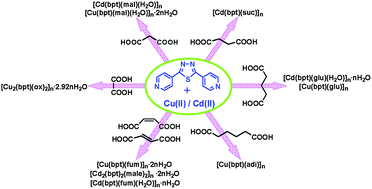Self-assembled coordination polymers of V-shaped bis(pyridyl)thiadiazole dependent upon the spacer length and flexibility of aliphatic dicarboxylate ligands†
Abstract
An investigation into ![[double bond, length as m-dash]](https://www.rsc.org/images/entities/char_e001.gif) CH,
CH,

Maintenance work is planned for Wednesday 1st May 2024 from 9:00am to 11:00am (BST).
During this time, the performance of our website may be affected - searches may run slowly and some pages may be temporarily unavailable. If this happens, please try refreshing your web browser or try waiting two to three minutes before trying again.
We apologise for any inconvenience this might cause and thank you for your patience.
* Corresponding authors
a
Key Laboratory of Synthetic and Natural Functional Molecule Chemistry of the Ministry of Education, Shaanxi Key Laboratory of Physico-Inorganic Chemistry, College of Chemistry & Materials Science, Northwest University, Xi'an, P. R. China
E-mail:
wyaoyu@nwu.edu.cn
Fax: +86-029-88303798
Tel: +86-029-88303798
An investigation into ![[double bond, length as m-dash]](https://www.rsc.org/images/entities/char_e001.gif) CH,
CH,

 Please wait while we load your content...
Something went wrong. Try again?
Please wait while we load your content...
Something went wrong. Try again?
G. Wen, Y. Wang, W. Zhang, C. Ren, R. Liu and Q. Shi, CrystEngComm, 2010, 12, 1238 DOI: 10.1039/B919381M
To request permission to reproduce material from this article, please go to the Copyright Clearance Center request page.
If you are an author contributing to an RSC publication, you do not need to request permission provided correct acknowledgement is given.
If you are the author of this article, you do not need to request permission to reproduce figures and diagrams provided correct acknowledgement is given. If you want to reproduce the whole article in a third-party publication (excluding your thesis/dissertation for which permission is not required) please go to the Copyright Clearance Center request page.
Read more about how to correctly acknowledge RSC content.
 Fetching data from CrossRef.
Fetching data from CrossRef.
This may take some time to load.
Loading related content
